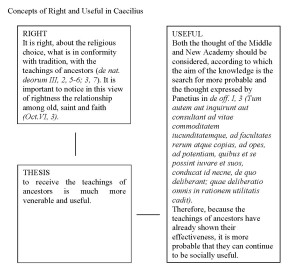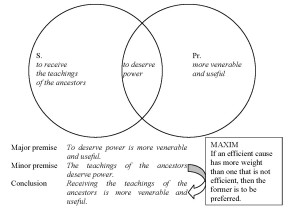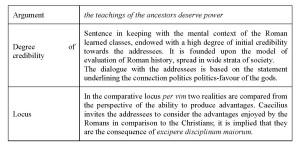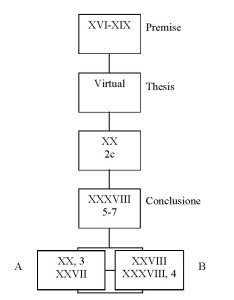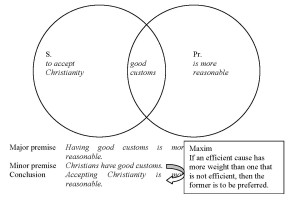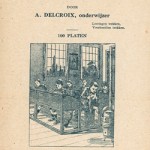ISSA Proceedings 2010 – Argumentative Structure In Octavius Of Minucius Felix: The Role Of The Thesis And The “Status Quaestionis” In The Development Of The Structure
No comments yet 1. Work and Author
1. Work and Author
Minucius Felix, the author of “Octavius”, is among the clearest and most original voices of Christian literature. A lawyer by profession, he was of African origins and lived and worked in Rome at the end of the second century. He was a contemporary of Tertullianus, but, unlike him, he is not in favour of an abrupt break with the classical tradition and prefers the ground of philosophical dispute. His literary work is the only one of the apologetical Latin literature in dialogue form. The dialogue takes place on the beach of Ostia and it involves three characters: the pagan Caecilius, the Christian Octavius and Minucius himself. Octavius reproaches Caecilius for worshipping a statue of the god Serapis and Caecilius suggests explaining their own reasons in support of their religious models, naming Minucius judge of the controversy. After the two speeches, however, the one made by Caecilius against Christianity and the other by Octavius in favour of Christianity, there is no need to come to a final judgment because Caecilius admits defeat. Minucius, with his dialogue, shows he is firmly convinced he is able to interact with his interlocutor, provided that they are both guided by reason and honesty. Minucius shows his argumentative intelligence not only in the tones he uses but also in the interweaving of the literary and philosophical references proposed by Octavius in his confutation of the pagan positions and consequent demonstration of the rationality of Christianity.
Since his work’s addressees are the learned pagans, the literary and philosophical sources he considers belong to the classical tradition, in particular to Cicero and Seneca, thus avoiding taking the Bible as the direct source of reference and authority. Minucius prefers emphasizing the differences in the continuity: “Octavius”, in fact, doesn’t mark the end of the classical world and the passage to Christianity on the line of an abrupt break with it, as proposed by Tertullianus, but on the acceptance, as common ground to share with the other, of the noblest principles of the Greek-Latin philosophical culture. In the cultural project of Minucius, there is no space for extreme radical positions; instead, features such as the search of coherence, the pursuit of knowledge and the fulfillment of the universal values of the “virtus” are central.
2. Methodology
The aim of this analysis is to investigate the relationship between the thesis, the structure and the nature of the arguments, trying to see how the thesis can produce and direct the structure and the phase of inventio. The disposition of the macrosequences of the arguments in support of the theses has been read and represented with the modalities of subordinative or coordinative argumentation (Eemeren, F.H. van, Grootendorst, R., & Snoeck Henkemans, A. F. 2002), while the evaluation of the arguments has been conducted through the classical topic. The two theses have been considered as the main generators of the monologues and they have been analyzed inside the hermeneutic categories of status qualitatis (Inst. Or. III, 6, 41-42; VII, 4, 2-3) and kairós.
To study a thesis inside the status qualitatis means considering the thesis according to vis, natura, genus. With vis I have intended to point out the direction imposed by the thesis in the: a) generation of arguments, b) generation of structure, c) generation of linguistic modalities pertinent to the proposed cultural model.
With the term natura inside the status qualitatis I have intended to point out the conceptual models of Right and Useful, that inform the thesis.
With the Greek concept of kairós we can philosophically understand the situational context, the balance between two opposing forces. I have intended kairós, in this proposal of analysis, as the relationship model between the speaker’s Weltanschauung and the expectation horizon of the audience.
3. Structure of Caecilius’s discourse
Since this work is constituted by two monologues, two diagrams have been worked out, one for each. First, the diagram related to the sermo of Caecilius will be analyzed. The reconstruction of Caecilius’s discourse in defense of his own standpoint (covering chapters V-XIII) has been conducted: a) identifying in each chapter of the work the functional unities which bring sense, b) grouping the chapters into wider sections (or blocks) each aimed at carrying out one of the communicative subprojects, according to which the general project of the text is articulated. This, in Caecilius’s discourse, is shown in three moments, following a three phase organization.
The two polar moments of defense and accusation are followed by the moment of the composition in the attenuated conclusion (quamquam). Every phase is aimed at embodying a subproject: in phase A (pars construens) Caecilius claims it is advisable to continue accepting the doctrine received by the ancestors, which is proposed as the best theological paradigm, in phase B (pars destruens) the orator attacks pagan rites and beliefs in an attempt to demolish their credibility as a valid alternative to his own proposal, in phase C (peroratio) conclusion, the arguments put forward in the Premise and Thesis are proposed again, though attenuated (quamquam). The second section B is divided internally into B’, where the Christian behaviours are considered cruel and irrational and B”, where the cosmological and metaphysical aspects of the Christian doctrine are considered groundless. In summary follows the content of the functional blocks: a) in chapters VI-VII Caecilius underlines the advisability of preserving the traditional religio, as the institution of the sacred rites has a motivated fundament and the traditional polytheistic religion has social utility, b) in chapters VIII-XII, in a derisive tone, accusations are made first to the Christians, defined as audacious, disrespectful and vulgar (VIII), then to their rites (IX), their God (X), their beliefs around conflagration, resurrection, final judgment (XI) and eternal life (XII), c) in chapter XIII, epilogue of Caecilius’s speech, the adoption of the system of doubt is proposed as the only reasonable attitude to deal with metaphysical problems. Once again, the image of the Christians as audacious and rash is presented and, in the conclusion, the arguments are drawn ex auctoritate from the academic philosophical tradition.
The general disposition of the proofs follows the Nestorian order with the strongest arguments in the first and last sections, distributing the weaker ones and gathering them together in the middle. In fact, in the chapters included in group B, the arguments against the Christians are often introduced by terms like fama, audio, alii dicunt, fabula, obscuritas: arguments of this species taken one by one, have a low persuasive potential. In the initial chapters of block A and in the conclusion, the proofs drawn from the authority of the ancient texts and from the Socratic philosophical tradition represent, in the beliefs of the orator, the arguments with the greatest weight.
The central structure of the discourse in two blocks (A and B) and the coordination between them spring, in the first instance, from the nature of the thesis, presented by the orator according to the comparative status qualitatis, that requires the comparison of the two philosophical models. The functional blocks A and B work together in order to support the thesis, every section responds to the thesis requirement: section A aims at proving how venerable and advantageous/useful (venerabilius ac melius) the traditional model is, section B proves that choosing Christianity as an alternative to the traditional religio is an unreasonable choice. From a dialogical point of view, section B adds complementary arguments supporting the thesis and it tries to prevent attacks on the arguments of pars construens (section A).
Structure of Caecilius’s discourse.
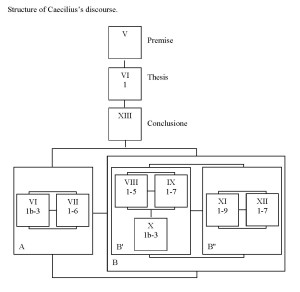
4. Difference of opinion.
The difference of opinion springs from the different points of view of the two debaters around the more correct and useful philosophical/religious model. It is mixed because different standpoints are adopted by the respective orators, who alternately in their discourses, play the roles of protagonist of their own thesis and antagonist of the other’s thesis (Eemeren, F.H. van, Grootendorst, R., & Snoeck Henkemans, A. F. 2002).
Question: what kind of life is better? (V, 1)
Caecilius Premise: everything in human matters is doubtful and uncertain. (V, 13)
Thesis: to receive the teachings of the ancestors is much more venerable and useful. (VI, 1)
Octavius Premise: I will convince you and I will show how false your opinions are through the confirmed and approved truth. (XVI, 4)
Thesis: accepting Christianity is more reasonable.
5. Analysis of the thesis
The thesis present in VI, 1 springs from the semantic content expressed in V, 13, of which it represents a res adiuncta (de diff. topicis 1200B, 1200C). In syllogistic terms, the thesis represents the unnecessary conclusion of a hypothetical enthymema having as premise V, 13b.
HOW MUCH MORE VENERABLE AND BETTER IT IS, TO RECEIVE THE TEACHING OF ANCESTORS. (VI, 1)
Before proceeding with the analysis, the thesis will be reduced and simplified in order to make the work easier. The textual segments which contain the leading thought of the orator can be identified in the sentence quanto venerabilius ac melius antistetem veritatis maiorum excipere disciplinam, which results in a thesis made up of two coordinate elements. The other eliminated indications can semantically be brought back into the two isolated statements.
This thesis, according to the Ciceronian model (Top. § 81), belongs to the genus cognitionis subpartition qualitas comparativa de maiore ad minus. Including the thesis in the genus cognitionis corresponds to the orator’s wish to consider the action of choosing the theological model as a result of a cognitive process. The protagonist intends to involve the addressees in a work leading to investigate the philosophical fields of physics and ethics.
The comparative status qualitatis inside which the thesis has been interpreted is linguistically determined both by a morphological level, through the comparative forms venerabilius ac melius which let us understand how to contrast two philosophical models, and by the semantic values of the two terms that place them in the word fields of honestum/honest, iustum/right and usefulness, belonging to the field of interest of the status qualitatis.
The genus causae, at which such a strategy of defense of the standpoint aims, is comparable to the genus deliberativum, concerning the matters related to dignitas, honestum, utile and characterized by the comparison and search for the greatest advantage. If we consider that in the concept of honestum there is the idea of pietas and that persuasion requires arousing emotion, we will understand how also the use of indignatio and of the genus dicendi turpe, in the following chapters (VIII, IX), is the fulfillment of the implications of the depth structure of thesis. The development of the discourse inside the model of the genus deliberativum also includes “the mind of those who have to decide must be touched not only by the nature of honesty, but by glory, by public opinion, and, if this vanity achieves poor results, by the demonstration of the advantages that they take from such things, or, on the other hand, of the possible risks, if they act in a different way” (Quint. Inst. Or. III, 8, 39).
The thesis presents a comparative elliptic form, containing implicitly the second term of comparison introduced by quam. Such a structured thesis gives instructions to the text, requiring from it the fulfillment of the two requests present in a comparative thesis: the acceptance of the validity of the traditional religious model and the demonstration of the inadvisability of accepting Christianity as an alternative to it. The features of the language of the presence, the defense of the tradition and its greatness, recall the genus dicendi grave as conceptual model, although the comparative forms amplified by how much more and the presence of the adjective melius/better in ascending position in comparison to venerabilius evoke the concept of prépon and the neutral genus dicendi (mesótes), which includes in itself the whole sentence. The genus mesótes will be the distinctive stylistic and philosophical mark of Caecilius’s sermo.
Therefore, the thesis morphé of the theological model will give information to the text also in relation to the genus dicendi: a weak theological model that does not imply a deep investigation into the religious dimension, characterized by the adherence to the tradition, the consideration of the advantages of such adherence and the social functions of religio.
Now a synoptical table of the analysis of the thesis is provided. The analysis is based on the categories of status and kairós:
| Short definition of disciplina maiorum | The set of teachings, customs, lifestyle of the ancestors. The respect of this was part of the pietas, and was felt as a guarantee of greatness, stability, as a pleasant thing to the gods. |
| Natura | Inside the comparative qualitas, the thesis implies that the discipline of the ancestors has been regarded ethically more honest, fairer and more useful than Christianity.The thesis springs from:– a model of the world founded upon a probabilistic concept of truth, on the respect for the ancestors, the country, the gods as guarantee of social unity.– Theological-epistemological, relativistic weak model, based on the religion and social utility connection.– An hermeneutic criterion, for the evaluation of history, based on the idea of the advantage achieved. |
| Kairós | – The thought expressed by the thesis is judged as endowed with a greater degree of probability in that communicative context.– The thesis conforms to common sense, to tradition; it is endowed with strong initial credibility for the social classes of academic, philosophical culture.– It demands of the addressee an immediate response to the proposed arguments. |
| Vis | The thesis implies:– the advisability of continuing to live according to the customs of the ancestors. Generation of matters founded upon the philosophical pragmatic model.– A model of elocutio founded upon the genus dicendi mesótes.– Genus tenue, indignatio for forms of thought contrary to the tradition.– The choice of the locus of comparison as a result of the comparative thesis.– A polar structure where two visions of the world are contrasted. |
6. Overview of arguments
While carrying out a work of analysis and synthesis on the whole discourse of Caecilius, it can be noticed that in order to defend the thesis in the construens section, the pagan orator puts forward three arguments: potestas meruerunt, vetustas, utile. Every argument is supported by the others with the aim of strengthening its idea. The three arguments are introduced as inferred from reality, from observation, therefore endowed with incontestable evidence.
In potestas meruerunt, the reflections on the fortune of Rome, on the historical events that have characterized its development and brought it to its current greatness are blended. The adoption of the traditional religious model and the fidelity to it is at the basis of the extension of Rome’s authority all over the world.
In vetustas, it is underlined how the religious tradition had been handed down without interruption for so many centuries and in the ancient world it was the custom to attribute the cults the same degree of holiness as their ancientness.
In utile there are observations related to the social function of the prophets, to their ability to predict the future, to give hope to the afflicted, to heal the sick. The arguments put forward by the two orators will be analyzed and valued with the tools offered by Cicero in the Topica and by Boethius. The theoretical starting points are the definitions of argumentum provided by Cicero as ratio quae rei dubiae facit fidem (Top. 2, 8) and by Boethius as medietatis inventio (In Cic. Top. 1051A).
The process of finding an argument, according to Boethius, consists essentially of finding an intermediate or middle term by means of which two terms whose connection is in doubt may be connected affirmatively. So, in our case, if in the definition of to receive the teachings of ancestors there is a semantic aspect that can be considered venerable and useful, then we can say that S. and Pr. can be connected. The middle term represents in a syllogism the substance or points out an aspect in relationship with the substance (Arist. An. Post. II, 11, 94a 20). To deserve power may be considered as a consequence of to receive the teachings of ancestors.
The res dubia is represented by the thesis quanto venerabilius ac melius disciplinam maiorum excipere, the argument (argumentum) object of the analysis is excipere disciplinam maiorum meruit potestatem.
Separating the thesis in Subject and Predicate we obtain the following syllogism:
The major premise represents the endoxon and finds its justification in the traditional hermeneutic model that considers both the greatness of Rome a gift of the gods, whose only compliance has made it possible to have the power, and all those excellent things worthy of veneration (Cic. de nat.deorum I, 17, 45 and III, 2, 5-6; 3, 7).
The passage from the minor premise to the conclusion is guaranteed by the maxim inferred from the locus of comparison per vim (Cic. Top. §70).
Example of synoptical table of argument analysis:
7. Macrostructure of the discourse of Octavius
The sermo of Octavius, to the level of dispositio, is realized in three following moments conforming itself to the dispositio of the accusation. In each section the arguments presented by the adversary in the correspondent functional blocks are analyzed and confuted. Chapters XVI-XIX represent the premise and attack the premises of Caecilius in chap. V. Chapters XX-XXVII confute the positions of Caecilius sustained in VI,VII. Chapters XXVIII-XXXVIII, 4 disprove the contained accusations in block B. Chapter XXXVIII, from 5 to 7 act as a conclusion. In his premise Octavius responds to the premise of probabilistic nature of Caecilius with the sentence of methodological nature “… convincam et redarguam,…, quae dicta sunt, a veritate confirmata probataque” (XVI, 4), and he continues attacking and disproving Caecilius’s arguments to support his general premise. The aim of the section consists of making the addressees acquire the idea that the harmony of the universe is the fruit of a rational mind and that instead of chance there is providence.
In block A he disproves the pars construens of Caecilius attacking and showing the rational appeals of paganism unfounded, alleging as proofs the easiness in believing in the fabulae, the irrationality, the violence and the obscenity of the cults, the sacrilegious attitude towards the divinities.
In block B he disproves the accusations of Caecilius about the customs and the theological beliefs of the Christians. This action is developed into three different points:
a) denying the accusation (status coniecturae), turning this against the adversary showing the pagan irrationality (translatio criminis) and maintaining the difference and superiority of the Christians (XXIX).
Through the percontatio, rephrasing the accusations addressed in the form of questions, followed by immediate answers that show the absurdity of the accusations (XXII,1).>
c) With motivation of the beliefs through the authority of the philosophical and historical tradition which, well investigated, confirms the Christian affirmations (XIX).
Chapter XXXVIII from paragraph 5 acts as peroratio introduced by a conjunction as proinde. It is not presented with an attenuation in the tone like the pagan one; it introduces a hard judgment on the sceptic and academic philosophical school claiming for the Christians the true wisdom (XXXVIII, 6), the true attainment of virtue.
The disposition of the res in two blocks responds both to the choice of Octavius to disprove the affirmations of Caecilius in a punctual way, section by section, and to the nature of the thesis structured on the comparative status qualitatis. Implicitly this demands that the reasons for which something is better than another are explained (useful for reflection on the concept of comparison, even though it is treated inside the qualitas iuridicialis, is the analysis of Cicero in de inv. 2, 74-78).
Therefore, to a constructive phase a side by side destructive phase is followed. In the case of the discourse of Octavius, initially we meet the destructive phase of the reasons alleged by Caecilius to motivate the choice of the tradition, then we find the constructive phase where he suggests the reasons for the choice of the alternative. To satisfy the thesis requirements the two blocks must be considered coordinated: each one of these has a task. In A Octavius attacks the pars construens of Caecilius, in B, disproving the accusations of Caecilius, he suggests for contrast the only rational choice. Section B is to be considered coordinated in an additive way to the preceding one. It adds further proofs against paganism affirming Christianity through the correctio (XXIX).
8. Analysis of the thesis
The formulation of the standpoint is reconstructed at a conceptual level starting from: a) the rational concept of unique God as principle guide on the earth and in the heaven (XVIII, 6), b) word fields having as matrix terms rationality (XXXV, 5, XXXVIII, 6) and reasoned choice (XXXII, 2; XXXIV, 5; XXXII, 3), c) ethical values alleged in the phase of correctio (est vobis licitum… non nobis), d) inter-textual reasons i.e. from the thesis expressed by other former apologists (see Justin I, 2, 1).
The comparative nature of the thesis can be deduced by XXXV, 5 and XXXVIII, 6 (nos… sed.). As criterion of choice the concepts of venerability and usefulness are contrasted, in the Christian thesis, with the concept of reason.
TO ACCEPT CHRISTIANITY IS MORE REASONABLE
Proposing the semantic analysis of the thesis within status and kairós we will have:
| Short definition of Christianity | Monotheistic religion founded on the person and on the preaching of Jesus Christ. It implies a new vision of God, a new relationship between God and men, a deep faith in Christ’s teachings. | |
| Natura | The semantic direction imposed by the status implies that the thesis must be interpreted on an ethical basis, according to the categories of honesty, justice and utility.The thesis springs from:– a strong, pervasive concept of knowledge.– a strong theological model founded upon the certainty of the existence of the truth.– A world governed by a rational mind. | |
| Kairós | – Thesis which is estranged from the common sense of the Roman learned classes, has the taste of the intellectual challenge.– It (kairós) is founded upon the trust that the addressees are prepared to interact and to activate a cognitive process together with the proponent.– It points at a new criterion of harmony not considered on the basis of a greater degree of probability of a thought in that precise moment, but founded upon the search for a single provable truth. | |
| Vis | The thesis implies:– Genus dicendi grave, to express the conviction of the existence of the truth.– Word fields of rationality, of order, of decency.– An absence of dichotomy between knowledge and practice.– The locus for comparison as a result of the comparative thesis.
– A structure built on the comparison of two antithetical philosophical models. – A high degree of commitment for the orator in showing the validity of his own thesis. |
|
Concepts of Right and Useful in Octavius
9. Overview of arguments
Octavius, in order to support his standpoint in block A, puts forward three arguments against the pars construens of Caecilius: improvidi (20, 5), ridiculi (22, 8 and 23, 2), sacrilegi (25, 7).
To improvidi are related the following ideas: excessive and rough simplicity in believing fanciful narrations, the non perfect knowledge of the nature of the divinity, the abandonment to other people’s mistake rather than conducting personal searches to authentically know and to have experience of the divine. The Christian aspires to a religiousness that is a result of personal choice and conviction and the intimate knowledge of God, through a direct relationship with him; human essence and divine essence in communication without mediations of idols and complex rites.
In ridiculus, the reflections on pagan rites converge: many and often in contrast among themselves, violent, deprived of rationality, honesty and decorum (23, 4).
In sacrilegus, there are considerations on the sacrilegious nature of enslaving the divinities of the subjugated people and then adoring them. In reality this means insulting and mocking the divinities. The observations on the real use of the temples as places to deal with rapists and adulterers confirm the use of the term sacrilegus for the pagans.
In phase B, where the ethical superiority of the Christians is affirmed and the consequent reasonableness of accepting Christianity, he brings forward as proofs the correctness (being correct) (XXXII, 3), God’s knowledge, honesty, modesty, reservation (XXXVII, 11). We are able to summarize all these values in the iunctura boni mores (good customs)
In the definition of Christianity, we find sober, longing for the truth, ethically correct. The endoxon is tied up to the classical concept of order, decency, measure in behaviour as an aspect of the reasonable quality of human nature (Cic. de off. I, 4; 5; 6).
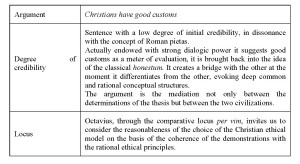
10. Comparison
The arguments in favour of the Christians, in the pars construens of the discourse of Octavius in block B, belong to the semantics of the rational choice; they concern concepts of rationality (XXXV, 5, XXXVIII, 6), reasoned decision (XXXII, 2), philosophical validity of the choice (XXXIV, 5), (XXXII, 3).
The model of the Christian God involves an ordered and comprehensible vision of the world and a congruence between cult and theology. It doesn’t contemplate the dissension between theory and practice, it involves the way of living according to wisdom, knowing the truth without falling in fault, according to temperance, pursuing order and decency. If the process of the final conversion of Caecilius to Christianity can take place, this is due to the fact that the pagan intellectual has recognized that if he intends to live really according to the purest values of the classical civilization, he must admit that in Christianity these find true fulfillment. The strength of Christianity resides in rationality and in coherence (XXVII, 5).
In Octavius the idea of a provable existing truth represents a reason of separation and union/agreement with the other. The discourse of the Christian, at the moment it enacts an incompatible difference with the other, builds a new dialogue, founded upon a different basis. In the pars destruens the middle terms chosen by Octavius in order to demolish the choice of paganism are not conciliatory and they represent a challenge for the other. They ask for a restructuring of the evaluation model of reality, a deep adhesion on a rational basis of the values of truth, of honesty, of the right. They meet the other on the ground of the reflection and the possibility of rediscovering the meaning of knowledge. They do not seek an easy point of meeting. They enact differences but do not destroy the possibility of a dialogue. Octavius appeals to the sense of justice and truth that has to animate every true philosopher; whoever wants the truth, has to look for the rationality of justice and ethics, has to rise above tradition, pragmatism, gnoseological relativism.
The choice of aggressive middle terms imposes a skimming, choosing who really wants to interact risking being convinced, who really wants to argue. The middle terms are blades that divide the incongruities and they demand a dialogue between men that rationally seek the truth. The middle terms of Caecilius in the pars construens recall the values of tradition, of social utility, of the cultural system and they express the belief that the political greatness of Rome is the result of the acceptance of that tradition. In the pars destruens the arguments are not founded upon real knowledge of the other, but they represent the acceptance of the widespread voices among the population. It is important to notice how the endoxa of Octavius’s reasoning belongs to the classical Weltanschauung, and the process of persuasion moves towards the breakup with the immediate acceptance of the tradition and towards the recovery of the universal value of reason.
We are all participants of reason and from this every kind of honesty and decorum is drawn. Octavius, in the field of ethics, appeals to the rational action according to knowledge and wisdom.
REFERENCES
Aristotle (1928b). Posterior Analytics. Ed.W. D. Ross. Oxford: Clarendon Press.
Boethius (1882-1891). In Ciceronis Topica. Ed. J. P. Migne. Patrologia latina, vol. LXIV, Paris: Garnier.
Boethius (1882-1891). De differentiis topicis. Ed. J. P. Migne. Patrologia latina, vol. LXIV, Paris: Garnier.
Fine modulo
Cicero (2002). Topica. Ed. T. Reinhardt. Oxford: Oxford University Press.
Cicero (1949). De Inventione. Ed. H.M. Hubbell. London: Heinemann.
Cicero (1949). De officiis. Ed. C Atzert. Leipzig: Teubner.
Cicero (1933). De Natura deorum. Ed. W.Ax. Leipzig: Teubner.
Eemeren, F.H. van, Grootendorst, R., & Snoeck Henkemans, A. F. (2002). Argumentation. Analysis, Evaluation, Presentation. Mahwah, NJ: Erlbaum.
Justin (1911). Ed. A. W. F. Blunt. The Apologies of Justin Martyr (in Cambridge Patristic Texts). Cambridge: A. I. Mason.
Minucius Felix (1963). Octavius. Ed. Michael Pellegrino. Torino: Paravia.
Quintilianus (1920). Institutio oratoria. Ed. H.E. Butler. Cambridge: Harvard University Press.
You May Also Like
Comments
Leave a Reply
